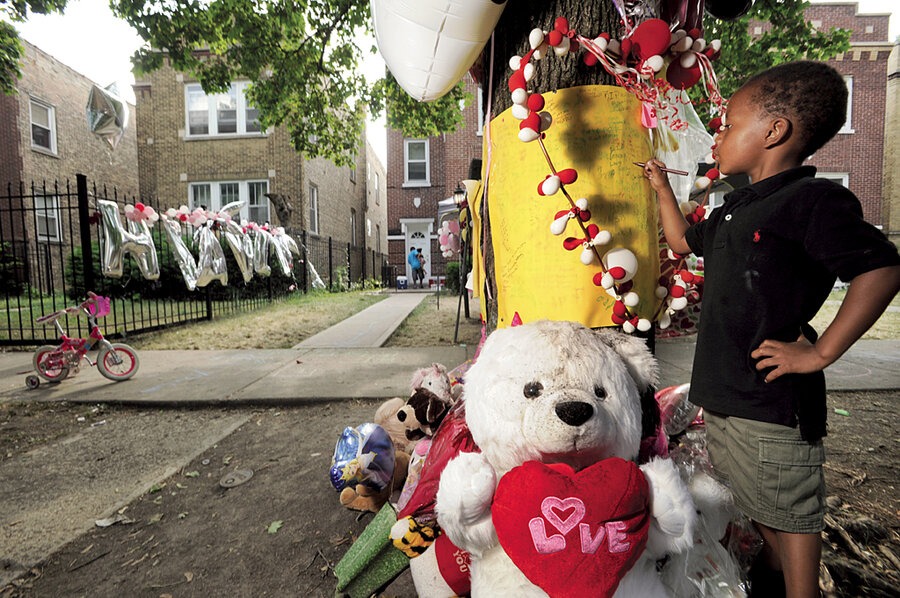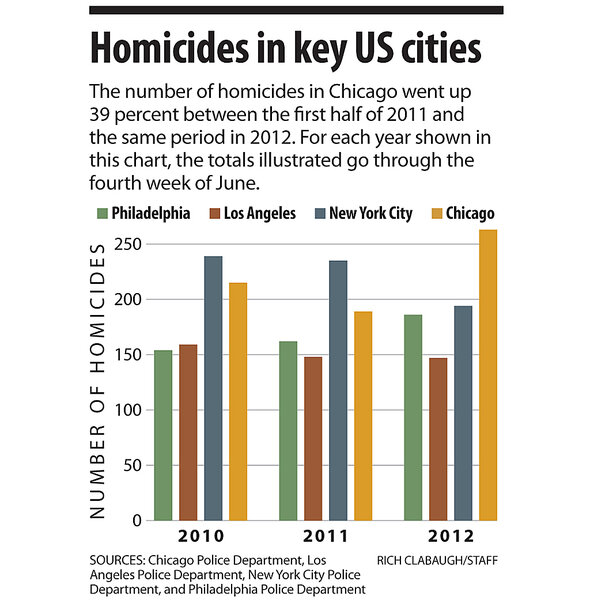In Chicago, heat and homicide stoke fear and frustration
Loading...
| Chicago
It's the weekend, but the streets are mostly empty in the Austin neighborhood on Chicago's impoverished far West Side.
"It's summertime! You don't see any kids out here," says Darrell Turner, grilling spits of meat as soul music blares from a radio. "They're too scared to come out." A squeeze of lighter fluid stokes the flames higher. He shakes his head: "different times."
Street violence has beset Chicago's poorest neighborhoods for years, but a spike in homicides since January – many of them shootings on public streets – has adults in neighborhoods like this one corralling their kids at home. That's doubly true since June 27 when, two blocks from where Mr. Turner works his grill, a spray of bullets ended the life of 7-year-old Heaven Sutton, the city's 251st homicide victim this year.
Year-to-date homicides are down in New York City and Los Angeles, but they are up 39 percent in Chicago, with 263 killings by the end of June.
Outrage is building as young children are increasingly caught in the line of fire. The number of public school students shot during the past school year jumped almost 22 percent from the year before, according to police figures. In June and July, more than one-fifth of the killings in each month were of people age 20 or younger.
Says Kaleiah Spencer, a 16-year-old who lives a block from where Heaven was shot: "You can barely walk the streets because you don't know what'll happen, who's going to shoot.
"Here, you hear gunshots, and you can't sleep," she says.
Murder rates need to be analyzed over a much longer period than a few months to track trends, criminologists say. Indeed, Chicago homicides are low compared with decades past – 928 in 1991 versus 433 in 2011, for example.
However, that hasn't blunted the perception that something is terribly wrong in Chicago, posing a serious test for the new administration of Mayor Rahm Emanuel. Adding to the alarm are statistics like this one: January-to-June murders here were 58 percent higher than the number of US troops killed in Afghanistan during the same period.
The police and city officials say street gangs are responsible for 80 percent of all shootings this year. Chicago recently surpassed Los Angeles – the longtime gang capital of America – in total gang membership and activity, say crime experts.
Just how many gangs operate in the Chicago area is debatable – sources say between 59 and 70, with as many as 150,000 members. But the big street gangs that dominated here in the early 1990s have splintered into as many as 600 factions, according to police. These splinter groups identify with the heritage of the long-established gangs – borrowing their name mainly as a brand – but they tend not to be bound by their rules.
Whereas the historic gang warfare was between monolithic crime organizations that controlled thousands of members each, today's street violence more often stems from personal squabbles and retaliatory conflicts among smaller hybrid groups whose control extends only a few blocks.
"Instead of fighting old enemies, when it was the Hatfields and the McCoys, now it's the McCoys and the McCoys," says Andrew Papachristos, a sociology professor at Yale University who has studied gangs in Chicago. "Gangs are no longer hierarchical. They are now much more elusive and complex."
Added to the mix – and no doubt raising the stakes – is the illicit drug trade. Chicago is the distribution hub for the Midwest, and its street gangs operate almost like corporate distributors for the Mexican cartels, say officials and criminologists. Four major cartels – Sinaloa, Los Zetas, Juarez, and Tijuana – have extended their networks into the Great Lakes region, according to the 2011 National Drug Threat Assessment from the Justice Department's National Drug Intelligence Center.
Law enforcement officials say they are changing their drug-fighting strategies to focus more on the cartels than on neighborhood dealers – and they've netted some fairly big fish of late. Last year, José Gonzalez-Zavala, who headed the Chicago distribution network of La Familia Michoacana cartel, was sentenced to 40 years in federal prison for distributing more than $5.7 million in cocaine through Illinois, Wisconsin, and Indiana. Then, in November, the FBI arrested 12 Chicago men associated with the Zetas cartel and charged them with conspiracy to possess and distribute cocaine, using safe houses on the West Side and in Berwyn, an adjoining suburb.
The greater cartel presence means "that almost the entire open-air drug market in Chicago is run by gangs" – a relatively recent trend, says Yale's Mr. Papachristos.
The Chicago Police Department (CPD), under new Superintendent Garry McCarthy, has also shifted its antigang strategies – and not without controversy. Previously, police responded to street shootings with blanket arrests of known gang members. Now, the department is conducting "gang audits" to assess turf fights and affiliations in a bid to prevent retaliation shootings. It is also tracking gang activity via Facebook and Twitter to pinpoint hot spots and to identify individuals projected to be involved in future violence.
"They're reviewing the shootings and linking people with specific groups," says Papachristos, who favors the new method. "It's an about-face from the old strategy of 'let's lock up every gang member.' "
CPD spokeswoman Lt. Maureen Biggane says beat officers now have at their fingertips data such as outstanding warrants, parole violations, and arrest records of all known gang members. "When one gang member commits a shooting, the entire gang is put on notice [by police], and they [all] are targeted," she says.
The group accountability approach resulted in the arrests of 488 members of the Maniac Latin Disciples since June 2011, when the gang was involved in two West Side shootings, Lieutenant Biggane says.
Some residents and city council members, though, want more aggressive tactics, such as random frisking or police strike forces. Mr. McCarthy, who most recently was police chief of Newark, N.J., does not grasp the nuances of policing Chicago, they complain.
"We need to bring the mobile strike force units back. They were ... highly motivated officers who had special training knowing how to come into the community and calm conflicts down with the gangs," says Anthony Beale, an alderman representing the city's Ninth Ward, on the far South Side.
Biggane counters that the latest strategy is designed to bring a more consistent police presence to the neighborhoods, with an eye to stabilizing the streets so that violence decreases over time. "They get to know the areas they are surveying. They are not simply popping in and popping out like the old teams did," she says.
For Mayor Emanuel, just 14 months into his term, the homicide spree is putting intense scrutiny on his administration's response. He was criticized after extra police officers were deployed to tourist-dominated downtown in the wake of a few street attacks and muggings, and after the Chicago Sun-Times reported in June that at least 100 police officers were sent to secure a wedding attended by President Obama.
"I don't think there's a recognition [in the mayor's office that] there's a full city out there," says Alderman Leslie Hairston of the Fifth Ward on the South Side. "[Emanuel] is from the North Side, and all his communities are being well served. But the programs and policies are not the same on the South Side. There's definitely a disparity."
Emanuel said recently that he appreciates the "impatience" of his city council critics and that he shares their alarm. He has lately launched initiatives to attack the violence from the back end – cracking down on convenience and liquor stores that he says can attract illegal activity and seeking to demolish about 200 buildings identified as gang havens. In late June, he announced $1 million for programs for CeaseFire – a violence-mediation program that enlists former gang members – for two neighborhoods on the South and West Sides.
Some say all the focus on gangs and police tactics is misplaced – and may not be the real problem. "The violence is largely spontaneous and out of control. It's triggered by all sorts of unrelated events," says John Hagedorn, a criminal justice professor at the University of Illinois at Chicago who studies gangs. "The whole policy discussion is not dealing with the long-term problem, and that's the inability of people to have hope."
City and state cuts to mentoring and summer programs in recent years directly correspond to more street violence, says Rick Velasquez of Youth Outreach Services, a group that serves Austin and other poor Chicago neighborhoods. The same week of Heaven's murder, Mr. Velasquez notes, he laid off 10 CeaseFire workers in Austin because state funding had run out.
"Violence is like a virus in how it spreads. Having adults around kids who are helping shepherd them is extremely important," he says. "Those things have been removed from the communities that ... need them the most."
In these tough fiscal times, cuts have been widespread. Last year, Chicago trimmed police spending by $67 million over the previous year. State, city, and Chicago Public School budgets are forecasting deficits, a sign that cuts to crime-prevention and social efforts may continue.
"The city is extremely serious about the crime problem, but the challenge you have ... is the budget situation," says Jens Ludwig of the University of Chicago Crime Lab, which researches gangs. "The idea you can take an ax to police, public schools, and social programs without seeing some kind of blowback on the crime problem doesn't seem realistic."








